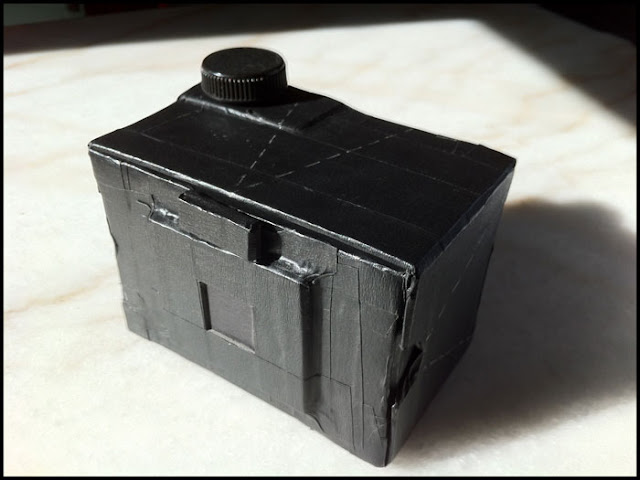I've made a couple variations just by measuring the parts out without using a printed pattern.
I mentioned in the post about the Glenmorangie Evil Cube that Sarah had given me a bottle of scotch for Christmas with the sentiment that she chose it because it looked the most like you could make a pinhole camera out of the box.
Scotch does generally come in some pretty sturdy boxes, and in this case, I really just used it as cardboard with a few folds already in the right place, and of course, I wanted the design on the box to look like it was made for the camera.
The width of a box of Scotch is just greater than the size of a 120 reel, so I added some foamcore spacers to get it right. The other dimension can be adjusted, but there really wasn't enough material to make a 6x9 and keep the pinhole where I wanted it on the design, and I think I've mentioned my inner cheapskate freaking out about only getting 8 pictures out of a role of 120 film, so it's 6x6cm.
The distance to the pinhole was again determined by how much cardboard I had while keeping the design of the box in place, which turned out to be 45mm. I used a .3mm Gilder electron microscope aperture, which is about the ideal size according to Mr. Pinhole.
I used it to photograph a gift I gave to Sarah that Christmas.
And of me rocking out in the basement.
A couple years later I got it out again to make Worldwide Pinhole Photography Day special, and submitted another variation on one of my favorite themes.
Last summer as part of my renewed interest in larger formats, I again loaded it up and set out to start a series on historic places in Oshkosh. Here's Oaks Candy, established in 1884. I had to buy a bunch of candy to justify taking up space in their store for this shot, but that's the price you pay for art.
I've always been fascinated with portrait painting. The poses required for sketching from life seem like something that could accommodate pinhole exposure times. A few years ago, my instructional media department inherited a photographic studio very near my office when the Publications department got one built near their main offices in another building. In my hopes for taking advantage of this, I built this 4.5 x 6 cm camera with a vertical format as it was mounted on the tripod which is a typical format for a portrait with a 6 cm distance to the pinhole yielding a relatively "normal" perspective to reproduce what a painter would be seeing with their eyes, although still a little wide for what we might consider for lens portraiture.
I never did get the guts to ask anyone to pose for me in the studio, except for that most convenient and cooperative model.
I did use it for a bit in the garden.
With both of these cameras I had problems with the film jamming up about the 9th or 10th frame. I thought it was because the film reels got out of parallel and bound up, but I've had the film smoothly go through in both at other times, and I never had a problem with the 120 Populist or the Stereo 120 Populist. I think it might have something to do with not advancing the film far enough on the take-up reel before I put it in the camera. On subsequent 120 cameras, I've been putting a second winder and some little axle in the bottom of the reel to make sure they remain parallel.
Sometimes problems lead to serendipity though. When I was working on the Portrait camera I was dealing with the worst personnel conflict of my career and took this face-palm shot just as I had read an email from one of the participants right after I got home from work. (Career advancement tip: Don't email the boss about problems right after work) The camera was in the process of jamming and after a series of aggressive twists just barely getting it to advance, I think it must have squeezed the film so hard it left these red marks on the image which I think enhanced the impression of frustration in the picture. I used it as my Facebook profile picture for about a year.











No comments:
Post a Comment